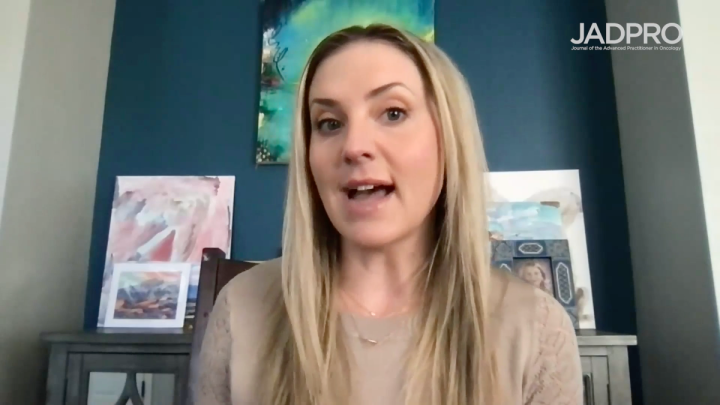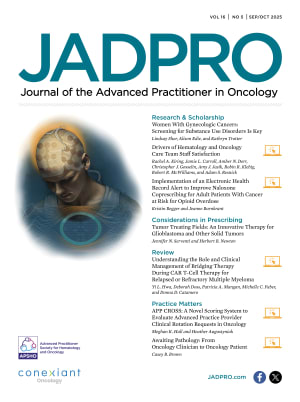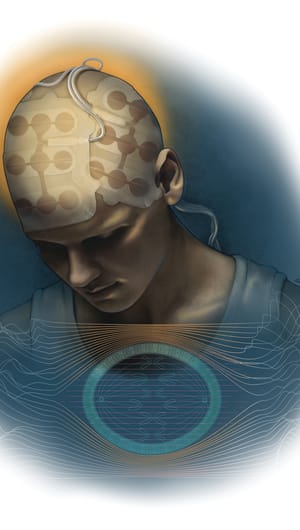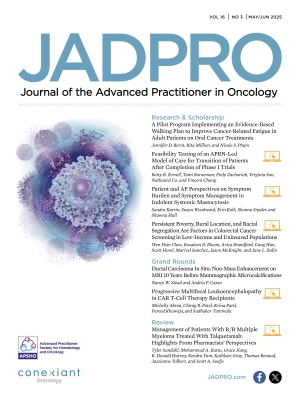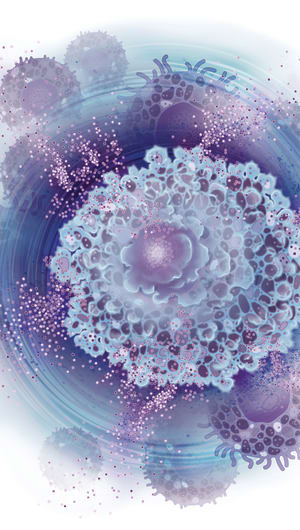Transcript
As a clinic pharmacist, I work in a sarcoma clinic with my providers, nurse practitioners, physicians, and nurses every day. We do see patients with a variety of sarcomas, including quite a few that actually do have what's considered to be a rare disease state, the desmoid tumors. As a clinic pharmacist, the role is a little bit different. We're kind of acting as an extra layer of support and second set of eyes on that patient when they first come in. As different therapies are discussed, especially when looking at systemic therapies, we're always making sure that the patient has been checked for renal clearance, their liver function, because that can be very important when it comes to selecting appropriate therapy for a patient.
We're also looking at what other medications the patient is on because a lot of the medications for desmoid tumors are often oral medications that do have a significant amount of drug potential interactions, and we want to make sure that the medications are as efficacious as well as safe for the patient with that regards as well. And also their concomitant comorbidities would be something that a pharmacist may look at in terms of how the drug may distribute or cause potential side effects for a patient.
Some considerations that we also have when we're looking at starting a systemic therapy are what dose to recommend for the patient. Sometimes our providers will say, "Hey, this patient has CKD, chronic kidney disease, or the patient is really concerned about side effects. They just seem to tell us that they have side effects to every single medication they take." So whether this is something that we can numerically quantify in terms of manufacturer recommended dose adjustments based upon the FDA labeling or based upon some trial data or pharmacokinetic data, we may suggest a dose adjustment for that patient.
However, if it's something where it's more qualitative where the patient is often timid or afraid to be starting a new medication, we can encourage them that in this disease state what's wonderful is that you do gain disease control when taking the medication, and the biggest complaint patients have in desmoid tumors is pain. So we really want to think about giving them the reason for why we want to start the medication and if the patient is still resistant, we may start at a lower dose for a week just so that they can test out and see how they handle the medication.
In terms of looking at adverse effects after a patient has started a medication, before we even get there, honestly, we try to head off the patient with a really sound patient counseling. So whether your clinic pharmacist is integrated into clinic, as in with our clinics, or whether your pharmacist is maybe somebody who gives you a phone call, maybe from the specialty pharmacy to walk you through a medication, we always want to make sure that that patient has had several iterations of being taught what to expect in terms of toxicity from the medication as well as what to do about that at home, if maybe it's a less significant side effect to try to maintain that dose intensity and maintain that efficacy for the patient.
I always make sure that my patients receive written material, they have all their questions answered in terms of what side effects they may expect from different medications to try to head off any potential reasons for dose adjustments and reduce those reasons. We also want to set the expectation with patients on oral medications that they are going to have frequent labs to make sure that they understand that just because it's oral and not going into an IV, that doesn't mean that this isn't something that we need to be monitoring for.
We have two medications that are often used orally as NCCN category one recommendations in desmoid tumors, and those are the nirogacestat and the sorafenib. With both of these medications, we are looking at different types of labs, especially the liver enzyme labs. So LFTs are something we want to monitor closely. We'll also be looking at the patient's electrolytes. So there's a variety of reasons why the patient's going to be counseled that they would come in more frequently for labs, as well as vital checks. For instance, with sorafenib, we have our patients come in more frequently to be checked and monitored for increases in blood pressure that can happen on patients who may never have had increased blood pressure before.
When thinking about those dose reductions, we really do like to exhaust all options before having to come to that necessity of having a dose reduction for a patient. For instance, if we have a patient who's on nirogacestat and they're having diarrhea, we would like to get that under control for the patient so that they can continue on their typical dosing of 150 milligrams twice a day. We'll obviously have given them at that point instructions on how to use Imodium properly. One of the most common counseling points with the Imodium is that our patients, when prescribed it, don't read the labeling or maybe don't understand the labeling and maybe they take one pill and it just doesn't work.
That's just not how the medication works. So they should be counseled on how to take the Imodium properly throughout the day up to eight tabs throughout the day. We’ll often move on to the next line of therapy such as Lomotil and there are additional lines beyond there if needed. We'll really want to exhaust those options before dose reducing for a patient, although we will sometimes give a patient a hold for a couple of days just to help them recover through that.
We'll also be looking at what was recommended in the study. For instance, if the patient has a certain level of LFT elevation, one thing that our AP providers can do to ensure that they're holding and adjusting medications when needed is to open the package insert, which is based upon the study and tells you if the grade of hepatotoxicity is 3 or 4. Depending on which drug you're looking at, we are not going to dose reduce or re-challenge and at that point we might need to have a discussion with the provider. Or maybe it's a grade 2 or 3 and we can re-challenge at a reduced dose depending on what that is.
For patient education talking points, I do see that we have two NCCN category one recommended medications. We have sorafenib and nirogacestat. For both medications really, we are counseling on diarrhea. For sorafenib specifically, I do use this medication in several disease states to be honest. I am seeing some potential cardio toxicity and hypertension, so you want to be cautious in patients who maybe have a history of cardiomyopathy or other cardiac complications. They may need more frequent monitoring than previously. And then all patients should of course be monitored for blood pressure changes as previously mentioned. We'll also be looking at that risk of potentially rash or even with the sorafenib, you may see some hand-foot syndrome. So making sure to counsel patients on trying to avoid things that would exacerbate that, like very hot showers, very tight shoes, and then looking at some complementing medications such as some urea topical hand cream for the hands and feet to help prevent that side effect.
We also could potentially see in both medication changes to fertility. We do know that with our second medication, the nirogacestat, we do have ovarian suppression. We do also have changes in fertility with sorafenib as well, so patients would want to be on contraception while on both of those medications. Our newer medication to the market, which is the nirogacestat, is a new targeted medication. This is a gamma-secretase inhibitor and it's something that was a first-in-class drug approval.
With this medication we do see some more diarrhea, so again, it's very important that the patient is counseled not only on the diarrhea, but also paying attention to signs of having electrolyte imbalances so they can call and report those if they are feeling them. They may feel a little bit more tired because of these electrolyte imbalances and the medication. They also may need some phosphorus replacements on the medication often due to the diarrhea or sometimes I've noticed it independent of the diarrhea as well. So that's something that's really important to pay attention to with the nirogacestat, and again, with both medications we are monitoring LFTs for potentially that liver toxicity. Some lesser-known things or less common things you may see with either medication, you may see proteinuria, it's less common, but if you are seeing a patient who's having changes in renal function and hypertension, it may be something worth looking into as well.
Overall, my take-homes for desmoid tumors are that they are rare, they can be painful. Hopefully many of our patients are seeking out information at centers that can give them great options. And there are again, two category 1 recommendations for patients that are both oral. So I think coordinating with your whole team to make sure that the patient has a solid patient education, patient knows what to do when they start to experience some of those less extreme side effects like maybe diarrhea or hand-foot syndrome is also very important to setting expectations. Like you will come in for labs and working with your providers so that they know if those labs come back and are not ideal, or maybe the labs come back and the provider needs to make an adjustment, knowing where those resources are to help preempt what adjustments may need to be made.

